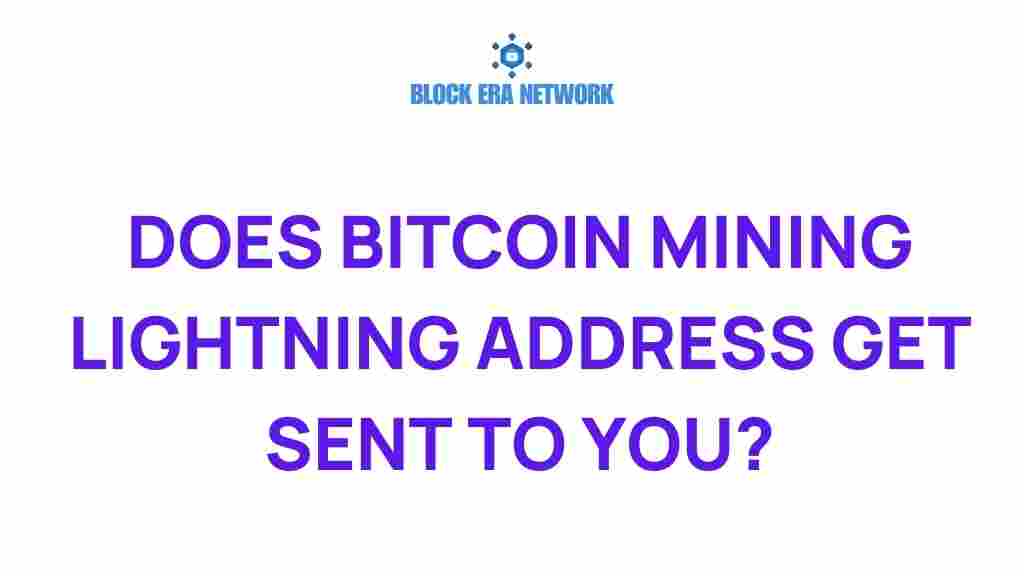Unraveling Bitcoin Mining: Do Lightning Addresses Reach You?
In the ever-evolving world of cryptocurrency, Bitcoin mining stands as a core component of the blockchain ecosystem. This process plays a pivotal role in validating transactions and introducing new coins into circulation. With the rise of decentralized finance and innovative technologies, understanding how Bitcoin mining works and its relationship with other aspects of the crypto world, such as Lightning addresses, is essential for anyone looking to navigate this digital landscape.
Understanding Bitcoin Mining
Bitcoin mining is the process by which new bitcoins are created and transactions are verified on the Bitcoin network. Miners use powerful computers to solve complex mathematical problems, which helps secure the network and process transactions. In return for their efforts, miners receive mining rewards in the form of newly minted bitcoins and transaction fees.
- Decentralization: Bitcoin operates on a decentralized network, meaning no single entity controls it.
- Security: The mining process secures the network by preventing double-spending and fraud.
- Incentive: Mining rewards provide an incentive for miners to maintain the integrity of the network.
The transaction process in Bitcoin involves several steps, from initiation to confirmation, and miners play a crucial role in this mechanism.
The Role of Lightning Addresses
As Bitcoin gained popularity, the need for faster transaction processes became evident. This led to the development of the Lightning Network, a second-layer solution designed to enable faster and cheaper transactions. Lightning addresses are crucial in this context, allowing users to send and receive payments almost instantaneously.
Key features of Lightning addresses include:
- Instant Transactions: Lightning addresses facilitate near-instantaneous payments between users.
- Lower Fees: Transactions on the Lightning Network typically incur lower fees than traditional Bitcoin transactions.
- Scalability: This technology enhances Bitcoin’s ability to handle a larger volume of transactions.
But the question remains: do Lightning addresses reach you directly through Bitcoin mining? To answer this, we need to explore the relationship between mining and the Lightning Network.
The Connection Between Bitcoin Mining and Lightning Addresses
While Bitcoin mining secures the main blockchain, the Lightning Network operates as a layer on top of it. Here’s how they connect:
- Transaction Verification: Miners validate transactions on the Bitcoin blockchain, while Lightning addresses enable off-chain transactions.
- Interoperability: Users can move funds between their on-chain Bitcoin wallets and Lightning wallets.
- Impact on Fees: High transaction volume on the main chain can lead to increased fees, making the Lightning Network a preferable choice for smaller transactions.
In summary, while Bitcoin mining does not directly interact with Lightning addresses, both play critical roles in the overall cryptocurrency ecosystem. Understanding this relationship can help users optimize their transaction strategies.
Step-by-Step Process of Using Bitcoin and Lightning Addresses
To effectively use Bitcoin and its Lightning counterpart, follow these steps:
Step 1: Set Up a Digital Wallet
Choose a reliable digital wallet that supports both Bitcoin and the Lightning Network. Popular options include:
- Exodus: A user-friendly wallet that supports multiple cryptocurrencies.
- BlueWallet: A mobile wallet with Lightning Network integration.
- Electrum: A lightweight wallet with advanced features for experienced users.
Step 2: Acquire Bitcoin
You can acquire Bitcoin through various methods, including:
- Exchanges: Use platforms like Coinbase or Binance to buy Bitcoin.
- Mining: If you have the resources, consider participating in Bitcoin mining.
- Peer-to-Peer Transactions: Trade with friends or use P2P platforms.
Step 3: Transfer Bitcoin to Your Lightning Wallet
Once you have Bitcoin in your digital wallet, transfer a portion of it to your Lightning wallet. This process typically involves:
- Opening your Lightning wallet.
- Selecting the option to receive funds.
- Generating a Lightning invoice.
- Using your main wallet to send Bitcoin to this invoice.
Step 4: Make Transactions Using Lightning Addresses
With funds in your Lightning wallet, you can now make transactions:
- Use Lightning addresses to send payments instantly.
- Scan QR codes for quick transactions.
- Enjoy lower fees compared to traditional Bitcoin transactions.
Troubleshooting Tips for Bitcoin and Lightning Transactions
While the process is generally straightforward, users may encounter issues. Here are some troubleshooting tips:
Common Issues and Solutions
- Transaction Not Confirmed:
- Check the block confirmation status on a blockchain explorer.
- Consider increasing the transaction fee for faster confirmation.
- Lightning Payment Failed:
- Ensure you have enough funds in your Lightning wallet.
- Verify that the Lightning channel is open and functioning.
- Wallet Sync Issues:
- Restart your wallet application.
- Check for updates to ensure you are using the latest version.
Conclusion: Embracing the Future of Cryptocurrency
Understanding Bitcoin mining and Lightning addresses is essential for anyone interested in the world of cryptocurrency. As the digital landscape continues to evolve, staying informed about these technologies will empower users to navigate the complexities of decentralized finance and maximize their experiences.
In summary, while Bitcoin mining plays a foundational role in the blockchain, Lightning addresses offer a solution for faster and cheaper transactions. By leveraging both, users can enhance their cryptocurrency journey.
For more information on cryptocurrency technologies, visit CoinDesk and explore their extensive resources.
Ready to dive deeper into the world of digital wallets? Check out our guide on choosing the right digital wallet for your needs.
This article is in the category Cryptocurrency Insights and created by Block Era Network Team
